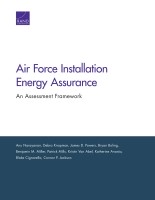| 来源类型 | Research Reports
|
| 规范类型 | 报告
|
| DOI | https://doi.org/10.7249/RR2066
|
| ISBN | 9780833098641
|
| 来源ID | RR-2066-AF
|
| Air Force Installation Energy Assurance: An Assessment Framework |
| Anu Narayanan; Debra Knopman; James D. Powers; Bryan Boling; Benjamin M. Miller; Patrick Mills; Kristin Van Abel; Katherine Anania; Blake Cignarella; Connor P. Jackson
|
| 发表日期 | 2017
|
| 出版年 | 2017
|
| 页码 | 118
|
| 语种 | 英语
|
| 结论 |
Air Force Installations in the Continental United States Have Generally Similar Architectures- A local commercial electrical utility generally supplies power to the entire installation. While there may be more than one power distribution line into a base, which provides some redundancy, only personnel from the commercial utility can typically switch power from one line to the other.
- While generators and other supplies may provide backup power for critical missions, access to fuel for generators is a key component of resilience capabilities. Scenarios that combine outages with constrained fuel delivery and/or reduced access to off-base personnel and parts can severely disrupt missions.
- Resilience capacities are often determined within individual organizational silos, not developed in the context of whole-base resources. This limits opportunities to develop efficient or novel solutions and limits visibility into dependence on single points of failure.
It Is Important to Define and Communicate Requirements- Requirements (e.g., acceptable mission downtime) are often poorly defined or not communicated by mission owners in a timely fashion to the base civil engineer. Even when requirements are specified, their technical basis and connection to mission goals are not always clear.
Bases Are More Likely to Have Effective Responses in Place for Common Events than for Less-Familiar Ones- The effects of exposure to different power-disruption scenarios on base capabilities are currently not systematically assessed. As expected, base personnel are typically well aware of the consequences events on base capabilities that have previously taken place and are ready to take necessary actions to cope.
|
| 摘要 |
- Mission owners should define energy requirements up front and clearly communicate them to the base civil engineer.
- Energy requirements should be clearly tied to mission goals and needs.
- Assessments of electric power requirements should account for interdependencies among electricity and other mission-essential infrastructures, such as water.
- Operators and planners should invest in gaining a better understanding of the effects of exposure to challenging scenarios that have not previously been experienced.
- To better understand priorities and dependencies, decisionmakers should look across missions at a given base and across bases that support a particular mission before investing in energy assurance upgrades.
- In choosing solutions to implement at different bases and in addition to analyzing costs, risks, and other base-specific considerations, decisionmakers should consider effects of possible changes in policy, environmental, or economic conditions that could constrain or render obsolete certain solutions.
|
| 主题 | Energy Distribution
; Energy Security
; Military Equipment
; Military Facilities
; United States Air Force
|
| URL | https://www.rand.org/pubs/research_reports/RR2066.html
|
| 来源智库 | RAND Corporation (United States)
|
| 引用统计 |
|
| 资源类型 | 智库出版物
|
| 条目标识符 | http://119.78.100.153/handle/2XGU8XDN/108602
|
推荐引用方式
GB/T 7714 |
Anu Narayanan,Debra Knopman,James D. Powers,et al. Air Force Installation Energy Assurance: An Assessment Framework. 2017.
|
|
文件名:
|
x1509985519324.jpg
|
|
格式:
|
JPEG
|

|
文件名:
|
RAND_RR2066.pdf
|
|
格式:
|
Adobe PDF
|
除非特别说明,本系统中所有内容都受版权保护,并保留所有权利。